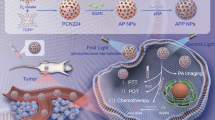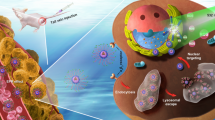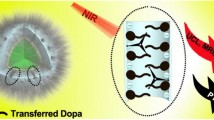Abstract
Photodynamic therapy is known for its non-invasiveness to significantly reduce undesired side effects on patients. However, the infiltration and invasiveness of tumor growth are still beyond the specificity of traditional light-controlled photodynamic therapy (PDT), which lacks cellular-level accuracy to tumor cells, possibly leading to “off-target” damage to healthy tissues such as the skin or immune cells infiltrated. Here, upconversion nanoparticles (UCNPs) were co-encapsulated with manganese dioxide (MnO2) by amphiphilic polymers poly(styrene-co-methyl acrylate) (PSMA) and further coated with photosensitizer (riboflavin)-loaded mesoporous silica (C@S/V). The C@S/V nanoprobes exhibited shielded upconversion luminescence in normal conditions (pH 7.4, no hydroperoxide (H2O2)) under 980-nm irradiation and thus minimal reactive oxygen production from riboflavin. However, the excess H2O2 (1 mM) and acidic environment (pH 5.5) could decompose the MnO2 within the C@S/V, resulting in remarkable enhancement of upconversion luminescence and a favorable hypoxia-relieving condition for PDT, providing a spatiotemporal signal for therapy initiation. The C@S/V nanoprobes were applied to the co-culture of normal cells (HEK293) and pancreatic cancer cells (Panc02) and performed a selective killing on Panc02 under the 980-nm irradiation. By using the “double-safety” strategy, a responsive C@S/V nanoprobe was designed by the selective activation of acidic and H2O2-rich conditions and 980-nm irradiation for spatiotemporally selective photodynamic therapy with cellular-level accuracy.
Graphical Abstract






Similar content being viewed by others
Data Availability
The data in this work are available from the corresponding author upon reasonable request.
References
Lee D, Shin J, Son H, Cheon SY, Lee Y, Park J, Koo H (2023) Nanoscale Adv 5:1600–1610
Chen HR, Wu FX, Xie XY, Wang W, Li QQ, Tu LP, Li B, Kong XG, Chang YL (2021) ACS Nano 15:20643–20655
Chi SY, Zuo MM, Zhu MT, Wang ZJ, Liu ZH (2022) ACS Appl Mater Interfaces 14:28671–28682
Yang YL, Chen R, Gong Y, Yang WH, Li K, Fan WZ, Gou SQ, Gao PF, He TT, Cai KY (2022) Biomaterials 287:121607
Chen M, Sun Y, Liu H (2023) Interdiscip Med 1:e20220012
Fang H, Wang X, Lan X, Jiang D (2023) Interdiscip Med 1:e20230002
Hu C, He XQ, Chen YX, Yang XT, Qin L, Lei T, Zhou Y, Gong T, Huang Y, Gao HL (2021) Adv Funct Mater 31:2007149
Chen X, Zhang Y, Zhang X, Zhang Z, Zhang Y (2021) Microchim Acta 188:349
Hu XC, Li H, Li RH, Qiang SF, Chen MY, Shi S, Dong CY (2022) Adv Healthc Mater 121:2202245
Li CX, Zhu P, Xiang HJ, Jin YJ, Lu BL, Shen YJ, Wang WP, Huang BJ, Chen Y (2023) Mater Today Bio 18:100513
Sun B, Bte Rahmat JN, Kim HJ, Mahendran R, Esuvaranathan K, Chiong E, Ho JS, Neoh KG, Zhang Y (2022) Adv Sci 9:2200731
Zhang Z, Jayakumar MKG, Zheng X, Shikha S, Zhang Y, Bansal A, Poon DJJ, Chu PL, Yeo ELL, Chua MLK et al (2019) Nat Commun 10:4586
Liu YL, Liang Y, Lei PP, Zhang Z, Chen YM (2022) Adv Sci 10:2203669
Ho TH, Yang CH, Jiang ZE, Lin HY, Chen YF, Wang TL (2022) Int J Mol Sci 23:8757
Lu Q, Wang Z, Bai S, Wang Y, Liao C, Sun Y, Zhang Y, Li W, Mei Q (2023) J Am Chem Soc 145:5941–5951
Fu X, Fu S, Lu Q, Zhang J, Wan P, Liu J, Zhang Y, Chen C-H, Li W, Wang H et al (2022) Nat Commun 13:4741
Chen H, Ding BB, Ma PA, Lin J (2022) Adv Drug Deliver Rev 188:114414
Du KM, Feng J, Gao X, Zhang HJ (2022) Light Sci Appl 11:222
Han DD, Zhang X, Ma YC, Yang XJ, Li ZH (2023) Mater Today Bio 18:100517
Hu X, Ha E, Ai FJ, Huang XJ, Yan L, He SQ, Ruan SC, Hu JQ (2022) Coordin. Chem Rev 473:214821
Yan JJ, Chen YB, Luo MH, Hu XY, Li HS, Liu QT, Zou ZZ (2023) J Biomed Sci 30:8
Zhang QF, Kuang GZ, Li WZ, Wang JL, Ren HZ, Zhao YJ (2023) Nano-Micro Lett 15:44
Dong ZL, Yang ZJ, Hao Y, Feng LZ (2019) Nanoscale 11:16164–16186
Zhong S, Chen C, Yang GL, Zhu YC, Cao HL, Xu BJ, Luo YQ, Gao Y, Zhang WA (2019) ACS Appl Mater Interfaces 11:33697–33705
Zhu JZ, Xiao TT, Zhang JL, Che HL, Shi YX, Shi XY, Van Hest JCM (2020) ACS Nano 14:11225–11237
Han K, Zhang J, Zhang W, Wang S, Xu L, Zhang C, Zhang X, Han H (2017) ACS Nano 11:3178–3188
Yang Z, Chen Q, Chen J, Dong Z, Zhang R, Liu J, Liu Z (2018) Small 14:1803262
Yang Y, Lin Y, Jiang L, Han W, Wang M, Lu C, Yang H (2020) ChemNanoMat 6:1054–1058
Wang X, Li M, Hou Y, Li Y, Yao X, Xue C, Fei Y, Xiang Y, Cai K, Zhao Y et al (2020) Adv Funct Mater 30:2000229
Yao C, Li Y, Wang Z, Song C, Hu X, Liu S (2020) ACS Nano 14:1919–1935
Dong X, Mu L-L, Liu X-L, Zhu H, Yang S-C, Lai X, Liu H-J, Feng H-Y, Lu Q, Zhou B-BS et al (2020) Adv Funct Mater 30:2000309
Zhang N, Zhao F, Zou Q, Li Y, Ma G, Yan X (2016) Small 12:5936–5943
Wang Y, Zhan J, Huang J, Wang X, Chen Z, Yang Z, Li J (2023) Interdiscip Med 1:e20220005
Feng YS, Ding DD, Sun WJ, Qiu YW, Luo L, Shi TH, Meng SS, Chen XY, Chen HM (2019) ACS Appl Mater Interfaces 11:37461–37470
Liu XM, Zhou YL, Xie WW, Liu SJ, Zhao Q, Huang W (2020) Small Methods 4:2000566
Ding BB, Zheng P, Ma PA, Lin J (2020) Adv Mater 32:1905823
Wan P, Fu H, Zhang Y, Liao C, Lu Q, Xu H, Mei Q (2023) Anal Bioanal Chem 415:4333–4341
Xue X, Uechi S, Tiwari RN, Duan Z, Liao M, Yoshimura M, Suzuki T, Ohishi Y (2013) Opt Mater Express 3:989–999
Homann C, Krukewitt L, Frenzel F, Grauel B, Würth C, Resch-Genger U, Haase M (2018) Angew Chem Int Ed 57:8765–8769
Zhou B, Tang B, Zhang C, Qin C, Gu Z, Ma Y, Zhai T, Yao J (2020) Nat Commun 11:1174
Chen S, Weitemier AZ, Zeng X, He L, Wang X, Tao Y, Huang AJY, Hashimotodani Y, Kano M, Iwasaki H et al (2018) Science 359:679–684
Zhou Y, Tao X, Chen G, Lu R, Wang D, Chen M-X, Jin E, Yang J, Liang H-W, Zhao Y et al (2020) Nat Commun 11:5892
Funding
The work was supported by the grants from National Natural Science Foundation of China (22074028), Guangdong Basic and Applied Basic Research Foundation (2023B1515020056, 2022A1515111012), Guangzhou Science and Technology Project (2023B03J1228), the Fundamental Research Funds for the Central Universities of China (21622106), and China Postdoctoral Science Foundation (2023M731314).
Author information
Authors and Affiliations
Contributions
H. F. and Q. L. contributed equally.
Corresponding authors
Ethics declarations
Competing interests
The authors declare no competing interests.
Additional information
Publisher's Note
Springer Nature remains neutral with regard to jurisdictional claims in published maps and institutional affiliations.
Supplementary Information
Below is the link to the electronic supplementary material.
604_2023_6022_MOESM1_ESM.docx
Supplementary file1 (DOCX 1100 KB) The Supporting Information is available free of charge on the ACS Publications website. Detailed experiment section; TEM figures of C@S with different ratio of PSMA and TEOS (Figure S1); TEM figures of C@S/V (Figure S2); The FTIR spectra of C@S and C@S/V (Figure S3); The UV-Vis absorbance of riboflavin solutions with different concentrations (Figure S4); The linear fitting curve of riboflavin concentration and UV-Vis absorbance (Figure S5); The upconversion luminescence spectra of C@S and C@S/V under the 980 nm excitation (Figure S6); The luminescence recovery in different timepoints of C@S/V (Figure S7 and Figure S8); TEM figures of UCNP/MnO2 nanoclusters after reaction in acidic H2O2 solutions (Figure S9); The singlet oxygen production of C@S/V under different conditions (Figure S10 and Figure S11) (PDF).
Rights and permissions
Springer Nature or its licensor (e.g. a society or other partner) holds exclusive rights to this article under a publishing agreement with the author(s) or other rightsholder(s); author self-archiving of the accepted manuscript version of this article is solely governed by the terms of such publishing agreement and applicable law.
About this article
Cite this article
Fu, H., Lu, Q., Zhang, Y. et al. Multi-target responsive nanoprobe with cellular-level accuracy for spatiotemporally selective photodynamic therapy. Microchim Acta 190, 448 (2023). https://doi.org/10.1007/s00604-023-06022-4
Received:
Accepted:
Published:
DOI: https://doi.org/10.1007/s00604-023-06022-4




